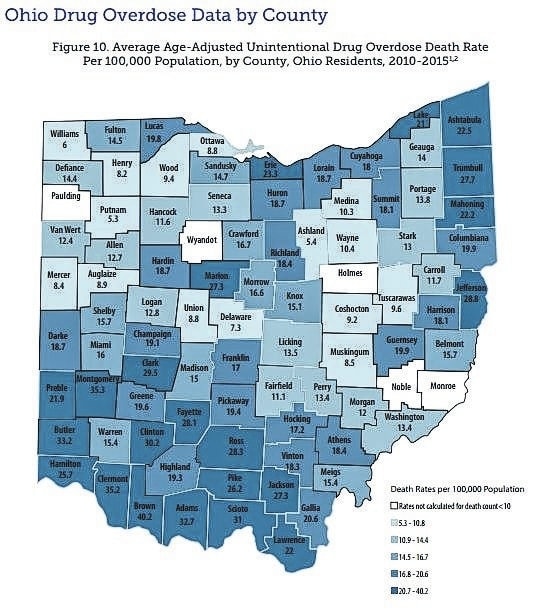
Unintentional drug overdose continued to be the leading cause of injury-related death in Ohio in 2015, ahead of motor vehicle crashes – a trend which began in 2007.
Unintentional drug overdoses caused the deaths of 3,050 Ohio residents in 2015, the highest number on record, compared to 2,531 in 2014. The number of overdose deaths increased 20.5 percent from 2014 to 2015, which is similar to the increase from 2013 to 2014.
In Fayette County, 16 deaths were attributed to unintentional drug overdoses in 2015, up 12 the prior year, according to Ohio Department of Health statistics. From 2010-15, Fayette County had 45 deaths attributed to unintentional drug overdoses.
Significant rise in fentanyl-related overdose deaths
As in 2014, the continued illicit use of a powerful opioid called fentanyl was a significant contributor to the rise in drug overdose deaths in 2015.
– Fentanyl-related unintentional drug overdose deaths in Ohio more than doubled from 503 in 2014 to 1,155 in 2015.
– Most often used to treat patients with severe pain, fentanyl is a Schedule II synthetic narcotic that in its prescription form is estimated to be 30 to 50 times more potent than heroin and 50 to 100 times more potent than morphine.
– Illicit fentanyl has been observed being mixed with other commonly-abused drugs, such as heroin, resulting in increased deaths between 2005 and 2007, and it seems to be reemerging in the U.S. People who use drugs may not know when illicit fentanyl has been combined with other drugs.
– Although pharmaceutical fentanyl may be diverted for abuse in the U.S., the majority of fentanyl drug reports and fentanyl reported with other drugs result from illegally produced and trafficked fentanyl, not diverted pharmaceutical fentanyl.
– The number of fentanyl drug reports based on law enforcement drug seizures increased in Ohio from 110 in 2013 to 3,882 in 2015. During the same period, fentanyl-related unintentional drug overdose deaths increased from 84 to 1,155.
– Fentanyl-related overdose deaths are categorized nationally as prescription opiate deaths even though it is believed that the vast majority of such deaths are the result of illegally produced and trafficked fentanyl. Of the 1,155 fentanyl-related unintentional overdose deaths in Ohio in 2015, only 30 deaths had a fentanyl prescription within 90 days of their death.
– Counties with the most fentanyl-related unintentional overdose deaths were Hamilton (195), Summit (111), Butler (104), Montgomery (102), Cuyahoga (83), Clermont (54), Clark (48), Lucas (41), Franklin (40), Stark (26), Trumbull (25), Lorain (21), and Greene (20). These counties account for 75 percent of fentanyl-realted unintentional overdose deaths in Ohio.
– Fentanyl-related overdose death is highest among persons 25 to 34 years of age (32 percent); and males (70.5 percent) were about 2.4 times more likely to die from fentanyl-related overdose compared to women (29.5 percent).
Number of heroin overdose deaths increased
– Heroin-related deaths accounted for 1,424 unintentional drug overdose deaths in 2015, an increase from 1,196 in 2014. Heroin was involved in 46.7 percent of all overdose deaths.
Prescription opioid overdose deaths declined
– Prescription opioid-related deaths accounted for 667 (21.9 percent) of unintentional drug overdose deaths in 2015, compared to 672 (26.6 percent) in 2014.
Opioids and multiple drug use help drive overdose rate
– Opioids (heroin, fentanyl and prescription) remained the driving factor behind unintentional drug overdoses in Ohio. In 2015, 2,590 (84.9 percent) of drug overdoses involved any opioid, compared to 2,020 (79.8 percent) in 2014.
– Unintentional drug overdose death from multiple drug use (where the number of drugs involved was specified) accounted for 1,747 (57.3 percent) in 2015, compared to 1,321 (52.2 percent) in 2014.
– Ohio’s annual age-adjusted death rate from unintentional drug overdoses in 2015 was 27.7 per 100,000 persons, compared to 22.8 in 2014. The age-adjusted death rate in Fayette County from 2010-15 was 28.1 per 100,000 persons, putting Fayette in the highest percentile of death rates per 100,000 population in all Ohio counties. This was the 11th-highest age adjusted rate out of all 88 Ohio counties.
Of contiguous counties, Madison was at 15 per 100,000 persons rate; Greene was at 19.6; Clinton at 30.2; Highland at 19.3; Ross at 28.3; and Pickaway 19.4.
Opioid prescribing trends in Ohio
Ohio officials have worked with the medical community to find the right balance between making sure that opioid pain interventions are available to patients who need them, and limiting the number of leftover opioid prescription medications available for diversion and abuse.
Established in 2011, the Governor’s Cabinet Opiate Action Team issued opioid prescribing guidelines for emergency departments and acute care facilities in 2012, prescribing guidelines for the management of chronic pain in 2013, and prescribing guidelines for the outpatient management of acute pain such as following surgery in 2016.
– The prescribing guidelines are designed to prevent “doctor shopping” for prescription opioids, to urge prescribers to first consider non-opioid therapies and pain medications to avoid the potential misuse and abuse of opioids, to reduce overprescribing leading to leftover opioids diverted for abuse, and to encourage prescribers to check the Ohio Automated Rx Reporting System (OARRS) before prescribing opioids to see what other controlled medications a patient might already be taking.
– In 2015, Ohio Gov. John R. Kasich announced an investment of up to $1.5 million a year to integrate OARRS directly into electronic medical records and pharmacy dispensing systems across the state, allowing instant access for prescribers and pharmacists. Also in 2015, the Ohio Board of Pharmacy linked OARRS data to ODH overdose death data, enabling the identification of patterns linking a number of overdose deaths to specific prescribers. The Pharmacy Board partners with prescriber regulatory boards to conduct joint investigations of such prescribers for violations of criminal laws.
This study entitled, “2015 Ohio Drug Overdose Data: General Findings,” was published by the Ohio Department of Health.


